Classical Greek Art and Architecture
- Greek Classical art considered the quintessence of art, the high point of ancient Greece art, of all art
- Athens, so wealthy, so forward, most sculptors, most evidence comes from Athens
- Even if sculptors weren’t from Athens, they moved there to practice their art
- Evidence is so limited from 480BCE- to the next 40 years because Athens was so badly destroyed, until the year 440BCE did they get funds to beautify, rebuild city
Delphi Charioteer
- c. 477, standing 5”11, votive offering, winner of chariot race offering to Apollo (chariot racing wasn’t naked, competitors wore
 clothes)
clothes) - It was bronze, rich yellow but turns a green colour, didn’t attempt to polish up, the Greeks liked it, with copper inlay over top
- Headband made of copper, silver, eyes with copper and onyx, a precious stone
- This statue was made in 8 different pieces then welded together, all hollow
- Stoic face, not smiling, not grimacing, almost poker-face, a small smile, very dignified
- It remained because it was on a ship that sank
- Most art copies of original bronze, marble was second tier
- When Barbarians invaded, they looted the bronze to melt it to make weapons
Riace Warriors
- C. 455, bronze, 6”9, 6”6, naked
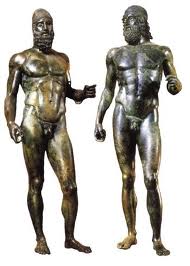
- Bronze was very rare, very few left (mostly found in shipwrecks)
- In less than a century, the imitation of the human body has been accomplished significantly, lots of dimension, posture, physique, real rippling, flowing hair, flawless weight distribution
- Working from most likely human models
- If it wasn’t for the shipwreck evidence, we’d think the statues are from much later
- Statues of grown men with a beard, way too tall than the average 5”8
- Copper nails, silver teeth, onyx eyes, broad shoulders, muscular
The Doryphoros
- 440 BC, 6”11,
- Contrapposto: Greek world admired equilibrium, balance, nothing in excess, symmetrical simplicity, in art as in life.
- After looking at so many, it becomes static, keeping the symmetry but bringing some life and vigor into the art, still maintaining balance on either side of the bodies (one side balanced by the other, relative harmony)
- Introduces in this statue some movement, in the Kouros statutes (Archaic statues depicting the ideal youth), they look frozen
- Michelangelo’s David, relaxed arm with relaxed leg, Renaissance artists happen to be there at the burst of art flourishing
Diadoumenos
- “Fillet-Binder,” 430 BC, 6”5
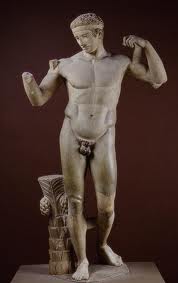
- With a ribbon that always indicates victory, probably a victorious athlete
- Christians covered genitals with fig leaf to cover up, Greeks themselves didn’t
- If your artistic goal is to represent the ideal, Greek art has already done it, what now? Modern art is all imaginative, grotesque
- Ideal of male body doesn’t change much from century to century, but the ideal of a women will change (now decade to decade)
- The Greek statues are still considered attractive males
Ordinary Greek women
- Mother and child, c. 420, clothed, captured in her youth, after death
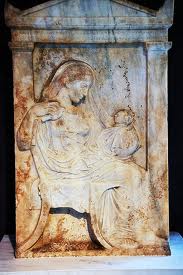
- Ampharete with child c. 430, clothed, veiled, in a revealing robe in her youth
- Aphrodite, Ludovisi Throne, c. 460, she’s clothed but as good as naked, coming out of a bath
- Definitely not how women dressed on a daily basis, but depicting them at their grave stone was appropriate
- Most women dressed modestly, with head cover
- No clothes is mistress or prostitute, not goddess or free citizen women
- Anthropocentric: human world view of the world
- Greeks interested in themselves, their own mind, standards
- Not much nature
Greek Architecture
- Cella (naos, Latin): place where the statue itself is, main room of the temple, with an altar, typically with a big statue of god or goddess
- Pronaos: shallow porch before your enter the main room (naos or Cella)
- Colonnade (Peristyle: series of columns that run around): a series of columns that run on the outside and around the main room
Post and Lintel construction
- Means series of rows or columns
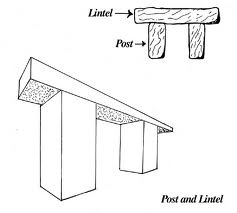
- post and lintel (π), two posts supporting a lintel, nothing in between instead of a solid wall, very heavy
- prime way to support their roof
- Parthenon was the maximum width that the number of pillars could support without collapsing, or else they’d have to put more pillars inside (blocking off space), hence slender long rectangular buildings
- Cathedrals usually shut out the rest of the world, Greek temples the exact opposite
- Not as opposing, solid, open area, with pillars letting in wind, light
- The whole are is for virgin goddess Athena, the temple dedicated to her, not the temple is hers the rest of the world is not
The Architectural Orders
- Capital: on top of the columns, on which the main beams rest
- Metope: broken up by three solid bars, decorative picture on each metope (Doric)
- Triglyph: each of the three bars (Doric)
- Frieze: a running series of images, kind of a mural (Ionic)
- Akroteria: little statues up on the roof
- Doric: square, simple, adorned capital, associated with people who were less artistic
- Ionic: more sophisticated, swirly ends capital, associated with Athenians in the north and the Ionians in the east, more decorative
- Parthenon has Doric, more simple capital
Temple at Aphaia, Aegina, 500-480 BC
- Made just before classical period begins
- Pediments: triangular roof, had carvings on it too
- In corners, the sculptor would carve fallen solders to fill up the space
Pericles; The Acropolis
- After being burned to the ground by Persia, Periciles was by far the most influential speaker, politician (in this radical democracy) and he decided to rebuilt the acropolis
- Parthenon (447-438): dedicated to Athena
- Propylaia (437-432): means in front of the games
- Erechtheion (435- 406): another temple tucked to the back, named after an emperor
- Athena Nike (c. 425): brings victory
Parthenon
- huge temples

- columns were very frequently used in ancient art and architecture
- Metopes, outside of the Parthenon (element of Doric temple)
- Interior Freize running all the way around inside Parthenon (element of Ionic), very hard to see, depicts big parades, in so much detail waiting for the Gods, glorifying naked figures, there will be intricate carving in columns that nobody on ground level can see, it’s for the Gods
- Mixed two elements of style: it functions but it’s ungainly, it’s daring
- Pediments: both sides depict something of Athena, Athena vs. Poseidon
Statue of Athena Promachos; Erectheus
- statue inside her temple, made entirely of gold and ivory
- Athena Nike depicted, symbol of victory, not the common Athena virgin
Erechtheion
- In Greek, “building for”
- A typical Greek temple is like the Parthenon, with columns and very light
- But the Erechtheoin is different looking, the pillars are women from conquered areas, their women supported their temple, their subservient
- Ionic Temple
Temple to Athena Nike
- Ionic, curly cues, running friezes, the figures are almost completely run away
- Stands right at the edge of the Acropolis
Athenian Red-Figure Vases: 500-400
- Coloured in the background, figures look red and background is black
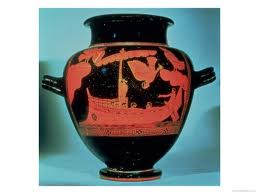
- Could have overlapping figures, increases image depth that the artist can do
- Still using clay and bronze, very hard to chip and damage them
- Originally it was red clay one layer and a different clay second layer that turned black
- in all of Greek history, they only have two surviving paintings
- the old style was the painting of the figures in black, the advancement with red figures allowed much more detail, more depth and dimension in the art, overlapping figures made possible, gives opportunity for artist to show much more skill
- later on, the illustration digresses from realism, the brush work is more free, exaggerated features, evidence of impressionism of the artist, more romantic style
